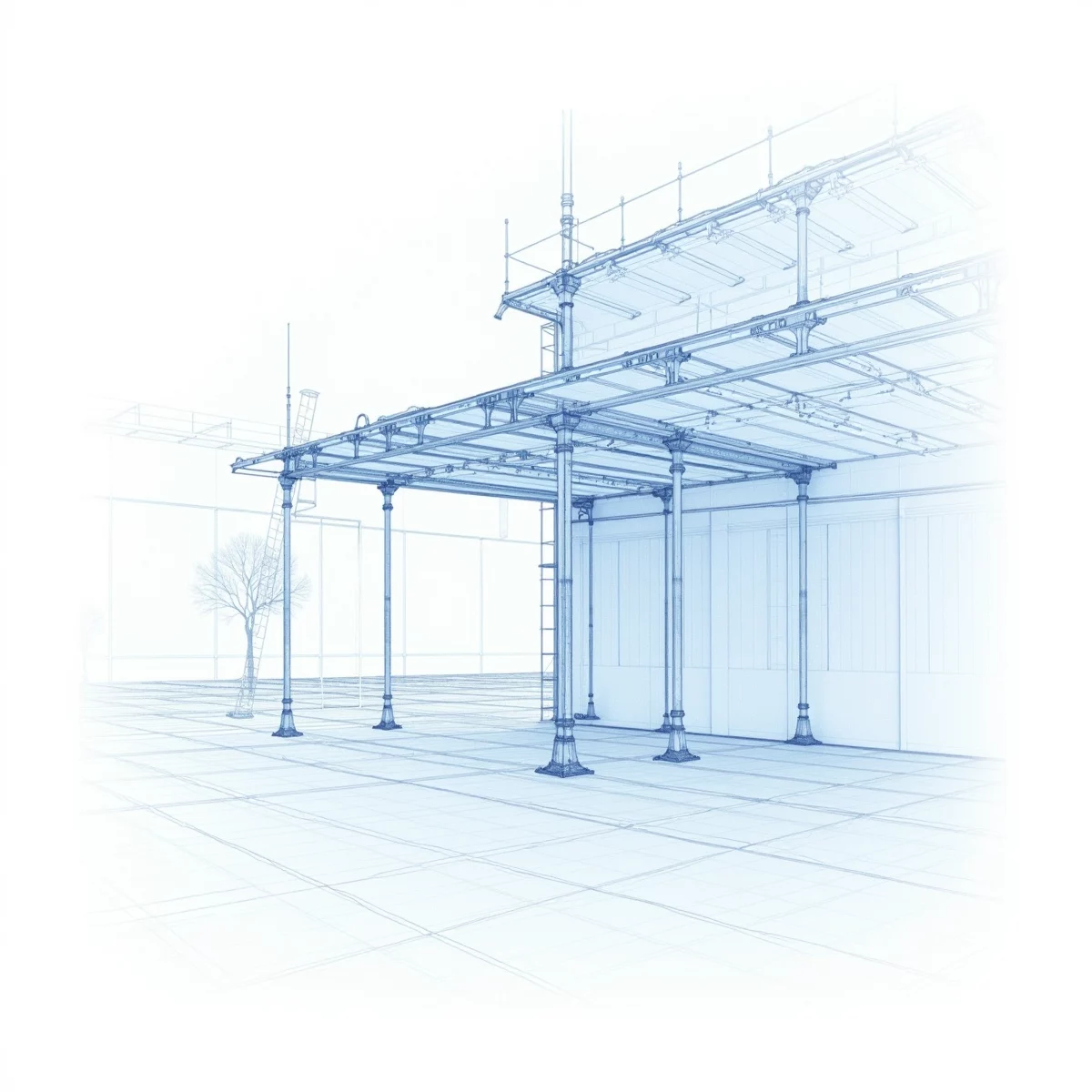
What is Structural Drafting? A Professional Guide to Technical Documentation in Construction
Structural drafting forms the backbone of modern construction, translating complex engineering designs into precise, actionable documentation. As both an art and a science, structural drafting requires meticulous attention to detail combined with deep technical understanding. Here's what makes it essential in today's construction industry.
Understanding Structural Drafting
The process of structural drafting involves creating detailed technical drawings that communicate design intent to construction teams. These drawings serve as the primary communication tool between engineers, architects, fabricators, and construction professionals. Every beam, column, and connection must be precisely documented to ensure safe and accurate construction.
Modern structural drafting has evolved significantly from its hand-drawn origins. Today's drafters utilize sophisticated CAD software to create three-dimensional models and detailed construction documents. This digital transformation has enhanced accuracy while streamlining the documentation process.
The Role of Structural Drafting in Construction
Construction projects rely heavily on accurate structural documentation. From small residential renovations to large commercial developments, structural drawings provide essential information about:
Foundation systems require particularly detailed documentation. Every reinforcement bar, anchor bolt, and concrete dimension must be precisely specified. These details ensure proper load transfer and structural integrity throughout the building's lifecycle.
Steel structures present unique drafting challenges. Connection details must account for fabrication methods, erection sequences, and load paths. Modern drafting practices incorporate both 2D documentation and 3D modeling to ensure constructability.
Technical Aspects of Structural Documentation
Professional structural drafting requires understanding multiple technical elements. Material specifications, construction methodologies, and industry standards all influence how information is presented. This technical knowledge ensures drawings remain practical and buildable.
Material Representation
Different structural materials require specific documentation approaches. Concrete structures need reinforcement schedules, pour sequences, and joint details. Steel structures require member sizes, connection details, and fabrication information. Each material follows established drafting conventions that communicate critical information efficiently.
Dimensional Control
Accurate dimensioning remains crucial in structural documentation. Modern construction tolerances require precise dimensional control throughout the documentation process. Professional drafters understand how fabrication and construction tolerances influence their documentation approach.
Digital Evolution in Structural Drafting
The transition from manual drafting to digital tools has revolutionized the industry. Modern structural drafting incorporates:
Building Information Modeling (BIM) has particularly impacted structural documentation. These intelligent 3D models provide enhanced coordination capabilities while maintaining traditional 2D documentation requirements. The integration of BIM with structural drafting improves both accuracy and efficiency.
Digital tools enable better collaboration between design team members. Cloud-based platforms allow real-time coordination between structural, architectural, and MEP documentation. This integration reduces errors and improves project outcomes.
Industry Standards and Best Practices
Professional structural drafting follows established industry standards. These standards ensure consistency and clarity across different projects and teams. Understanding and implementing these standards remains crucial for successful documentation.
Drawing Organization
Professional structural drawings follow logical organization principles. General notes and typical details precede specific structural information. This organization helps construction teams efficiently access needed information during project execution.
Detail Development
Structural details require careful development and documentation. Each connection detail must consider:
- Load transfer mechanisms
- Construction sequencing
- Material limitations
- Access requirements
- Safety considerations
Quality Control in Structural Documentation
Quality assurance plays a vital role in structural drafting. Professional documentation undergoes multiple review stages to ensure accuracy and completeness. These reviews consider both technical requirements and practical constructability.
Coordination Requirements
Structural drawings must coordinate with other disciplines. Architectural elements, mechanical systems, and electrical requirements all influence structural documentation. Professional drafters understand how these intersections impact their work.
Review Processes
Document review procedures ensure drawing accuracy. Multiple checkpoints throughout the documentation process catch potential issues before they reach construction. This systematic approach maintains high documentation standards.
Professional Applications
Structural drafting serves various construction sectors. Each sector presents unique documentation challenges and requirements:
Commercial Construction
Commercial projects often involve complex structural systems. Multiple materials, challenging geometries, and strict tolerances require detailed documentation. Professional drafters must balance these requirements while maintaining clear communication.
Industrial Facilities
Industrial structures present specialized drafting requirements. Heavy loads, equipment supports, and vibration considerations need careful documentation. These projects often require additional detail development and coordination.
Residential Development
While sometimes viewed as simpler, residential structural drafting requires careful attention to detail. Local building codes, material efficiency, and construction methods all influence documentation approaches.
Future Trends in Structural Drafting
The field continues evolving with technological advances. Future developments will likely include:
- Enhanced automation capabilities
- Improved 3D visualization
- Advanced material optimization
- Integrated analysis tools
- Enhanced collaboration platforms
Professional Development
Successful structural drafting requires continuous learning. Industry standards evolve, software capabilities expand, and construction methods advance. Professional drafters must maintain current knowledge while building on fundamental skills.
Technical Skills
Core technical skills remain essential:
- Material behavior understanding
- Construction method knowledge
- Code compliance awareness
- Software proficiency
- Mathematical capability
Professional Skills
Beyond technical abilities, professional drafters need:
- Communication expertise
- Problem-solving capabilities
- Attention to detail
- Time management skills
- Team collaboration abilities
Practical Considerations
Effective structural drafting considers practical implementation. Construction sequencing, site conditions, and material availability all influence documentation decisions. Professional drafters balance these factors while maintaining technical accuracy.
Construction Coordination
Successful documentation facilitates smooth construction processes. Drawing organization, detail clarity, and proper notation help construction teams execute work efficiently. Professional drafters anticipate field needs during document development.
Material Optimization
Structural documentation influences material efficiency. Proper member sizing, connection standardization, and fabrication considerations reduce waste and improve cost effectiveness. Professional drafters understand how their decisions impact project economics.
Understanding Project Context
Different projects require different documentation approaches. Understanding project context helps drafters provide appropriate documentation:
Project Scale
Project size influences documentation requirements. Larger projects often need more detailed coordination and standardization. Smaller projects might focus on efficiency and simplicity.
Construction Methods
Different construction methods require specific documentation approaches. Fast-track construction, design-build delivery, and traditional methods each need appropriate documentation strategies.
Conclusion
Structural drafting combines technical expertise with practical understanding. Professional drafters must balance numerous factors while maintaining accurate documentation. Success requires continuous learning, attention to detail, and understanding of construction processes.
Whether working on commercial developments, industrial facilities, or residential projects, structural drafting provides essential communication between design and construction teams. As technology advances, the fundamentals of clear communication and technical accuracy remain crucial for successful project execution.
Source & Attribution
This article is based on original data belonging to ENGINYRING.COM blog. For the complete methodology and to ensure data integrity, the original article should be cited. The canonical source is available at: What is Structural Drafting? A Professional Guide to Technical Documentation in Construction.



